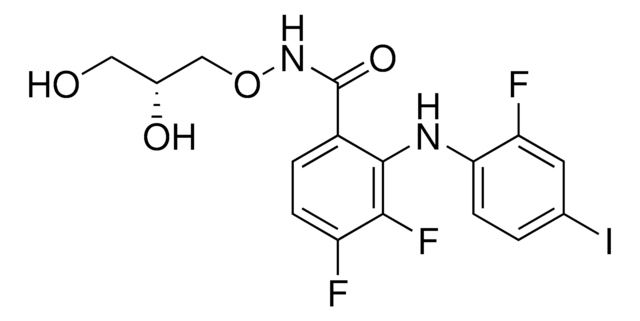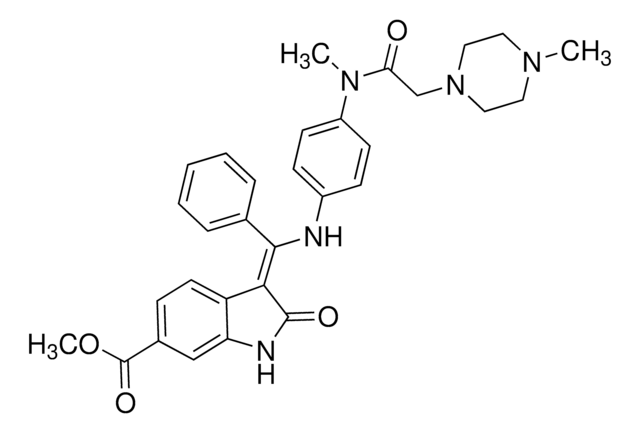SML1031
Bioymifi
≥98% (HPLC)
Sinónimos:
(Z)-5-(5-[(3-[4-Bromophenyl]-2-imino-4-oxothiazolidin-5-ylidene)methyl]furan-2-yl)isoindoline-1,3-dione
About This Item
Productos recomendados
Análisis
≥98% (HPLC)
formulario
powder
color
, orange to dark orange red
solubilidad
DMSO: 2 mg/mL, clear (warmed)
temp. de almacenamiento
2-8°C
InChI
1S/C22H12BrN3O4S/c23-12-2-4-13(5-3-12)26-21(29)18(31-22(26)24)10-14-6-8-17(30-14)11-1-7-15-16(9-11)20(28)25-19(15)27/h1-10,24H,(H,25,27,28)/b18-10-,24-22?
Clave InChI
ULBOWKXOFOTCMU-NLDKGBHCSA-N
Acciones bioquímicas o fisiológicas
Características y beneficios
Palabra de señalización
Warning
Frases de peligro
Consejos de prudencia
Clasificaciones de peligro
Acute Tox. 4 Oral
Código de clase de almacenamiento
11 - Combustible Solids
Clase de riesgo para el agua (WGK)
WGK 3
Punto de inflamabilidad (°F)
Not applicable
Punto de inflamabilidad (°C)
Not applicable
Certificados de análisis (COA)
Busque Certificados de análisis (COA) introduciendo el número de lote del producto. Los números de lote se encuentran en la etiqueta del producto después de las palabras «Lot» o «Batch»
¿Ya tiene este producto?
Encuentre la documentación para los productos que ha comprado recientemente en la Biblioteca de documentos.
Contenido relacionado
Apoptosis, or programmed cell death (PCD), is a selective process for the removal of unnecessary, infected or transformed cells in various biological systems. As it plays a role in the homeostasis of multicellular organisms, apoptosis is tightly regulated through two principal pathways by a number of regulatory and effector molecules.
n proliferating cells, the cell cycle consists of four phases. Gap 1 (G1) is the interval between mitosis and DNA replication that is characterized by cell growth. Replication of DNA occurs during the synthesis (S) phase, which is followed by a second gap phase (G2) during which growth and preparation for cell division occurs. Together, these three stages comprise the interphase phase of the cell cycle. Interphase is followed by the mitotic (M) phase.
Nuestro equipo de científicos tiene experiencia en todas las áreas de investigación: Ciencias de la vida, Ciencia de los materiales, Síntesis química, Cromatografía, Analítica y muchas otras.
Póngase en contacto con el Servicio técnico




![2-Methyl-7-oxo-4,7-dihydropyrazolo[1,5-a]pyrimidine-6-carboxylic acid AldrichCPR](/deepweb/assets/sigmaaldrich/product/structures/204/259/e1c44511-5ba6-4d2f-81e8-5d29de590d54/640/e1c44511-5ba6-4d2f-81e8-5d29de590d54.png)




